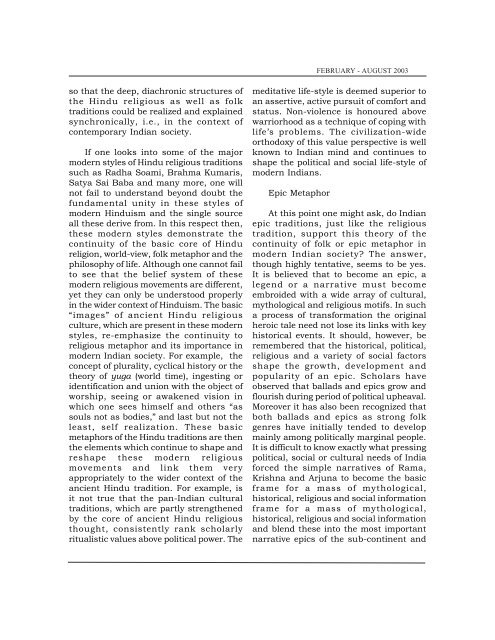Epics in Imprints-1.pdf - Vivekananda Kendra Prakashan
Epics in Imprints-1.pdf - Vivekananda Kendra Prakashan
Epics in Imprints-1.pdf - Vivekananda Kendra Prakashan
You also want an ePaper? Increase the reach of your titles
YUMPU automatically turns print PDFs into web optimized ePapers that Google loves.
so that the deep, diachronic structures of<br />
the H<strong>in</strong>du religious as well as folk<br />
traditions could be realized and expla<strong>in</strong>ed<br />
synchronically, i.e., <strong>in</strong> the context of<br />
contemporary Indian society.<br />
If one looks <strong>in</strong>to some of the major<br />
modern styles of H<strong>in</strong>du religious traditions<br />
such as Radha Soami, Brahma Kumaris,<br />
Satya Sai Baba and many more, one will<br />
not fail to understand beyond doubt the<br />
fundamental unity <strong>in</strong> these styles of<br />
modern H<strong>in</strong>duism and the s<strong>in</strong>gle source<br />
all these derive from. In this respect then,<br />
these modern styles demonstrate the<br />
cont<strong>in</strong>uity of the basic core of H<strong>in</strong>du<br />
religion, world-view, folk metaphor and the<br />
philosophy of life. Although one cannot fail<br />
to see that the belief system of these<br />
modern religious movements are different,<br />
yet they can only be understood properly<br />
<strong>in</strong> the wider context of H<strong>in</strong>duism. The basic<br />
“images” of ancient H<strong>in</strong>du religious<br />
culture, which are present <strong>in</strong> these modern<br />
styles, re-emphasize the cont<strong>in</strong>uity to<br />
religious metaphor and its importance <strong>in</strong><br />
modern Indian society. For example, the<br />
concept of plurality, cyclical history or the<br />
theory of yuga (world time), <strong>in</strong>gest<strong>in</strong>g or<br />
identification and union with the object of<br />
worship, see<strong>in</strong>g or awakened vision <strong>in</strong><br />
which one sees himself and others “as<br />
souls not as bodies,” and last but not the<br />
least, self realization. These basic<br />
metaphors of the H<strong>in</strong>du traditions are then<br />
the elements which cont<strong>in</strong>ue to shape and<br />
reshape these modern religious<br />
movements and l<strong>in</strong>k them very<br />
appropriately to the wider context of the<br />
ancient H<strong>in</strong>du tradition. For example, is<br />
it not true that the pan-Indian cultural<br />
traditions, which are partly strengthened<br />
by the core of ancient H<strong>in</strong>du religious<br />
thought, consistently rank scholarly<br />
ritualistic values above political power. The<br />
FEBRUARY - AUGUST 2003<br />
meditative life-style is deemed superior to<br />
an assertive, active pursuit of comfort and<br />
status. Non-violence is honoured above<br />
warriorhood as a technique of cop<strong>in</strong>g with<br />
life’s problems. The civilization-wide<br />
orthodoxy of this value perspective is well<br />
known to Indian m<strong>in</strong>d and cont<strong>in</strong>ues to<br />
shape the political and social life-style of<br />
modern Indians.<br />
Epic Metaphor<br />
At this po<strong>in</strong>t one might ask, do Indian<br />
epic traditions, just like the religious<br />
tradition, support this theory of the<br />
cont<strong>in</strong>uity of folk or epic metaphor <strong>in</strong><br />
modern Indian society? The answer,<br />
though highly tentative, seems to be yes.<br />
It is believed that to become an epic, a<br />
legend or a narrative must become<br />
embroided with a wide array of cultural,<br />
mythological and religious motifs. In such<br />
a process of transformation the orig<strong>in</strong>al<br />
heroic tale need not lose its l<strong>in</strong>ks with key<br />
historical events. It should, however, be<br />
remembered that the historical, political,<br />
religious and a variety of social factors<br />
shape the growth, development and<br />
popularity of an epic. Scholars have<br />
observed that ballads and epics grow and<br />
flourish dur<strong>in</strong>g period of political upheaval.<br />
Moreover it has also been recognized that<br />
both ballads and epics as strong folk<br />
genres have <strong>in</strong>itially tended to develop<br />
ma<strong>in</strong>ly among politically marg<strong>in</strong>al people.<br />
It is difficult to know exactly what press<strong>in</strong>g<br />
political, social or cultural needs of India<br />
forced the simple narratives of Rama,<br />
Krishna and Arjuna to become the basic<br />
frame for a mass of mythological,<br />
historical, religious and social <strong>in</strong>formation<br />
frame for a mass of mythological,<br />
historical, religious and social <strong>in</strong>formation<br />
and blend these <strong>in</strong>to the most important<br />
narrative epics of the sub-cont<strong>in</strong>ent and

















